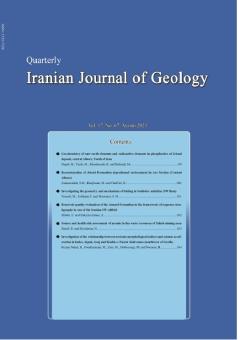-
-
List of Articles
-
Open Access Article
1 - Geochemistry of rare earth elements and radioactive elements in phosphorites of Jeirud deposit, central Alborz, North of Iran
milad najafi Mohammad yazdi khalegh khoshnoodi mehrdad behzadi -
Open Access Article
2 - Reconstruction of Jeirud Formation depositional environment in Aro Section (Central Alborz)
Seyed Mohammad Zamanzadeh M. Ranjbaran K. Ghaffari -
Open Access Article
3 - Investigating the geometry and mechanism of folding in Sulabder anticline (SW Iran)
Mehdi Yosefi F. Esfahani Seyd Morteza Moussavi -
Open Access Article
4 - Reservoir quality evaluation of the Asmari Formation in the framework of sequence stratigraphy in one of the Iranian SW oilfield
Ebrahim Sfidari A. Hakymi-Zanuz -
Open Access Article
5 - Source and health risk assessment of arsenic in the water resources of Takab mining area
N. Heydarian -
Open Access Article
6 - Investigation of the relationship between tectonic morphological indices and seismic acceleration in Indes, Aipak, Avaj and Kushk-e-Nusrat fault zones (northwest of Saveh)
bahar Rezaei nahal Mohsen Pourkermani M. Zare M. Dehbozorgi R. Nozaem
-
The rights to this website are owned by the Raimag Press Management System.
Copyright © 2017-2026







